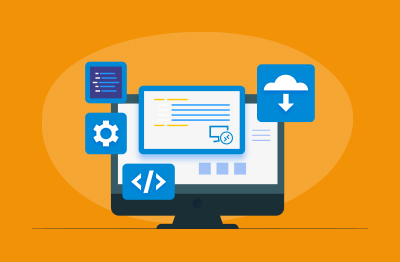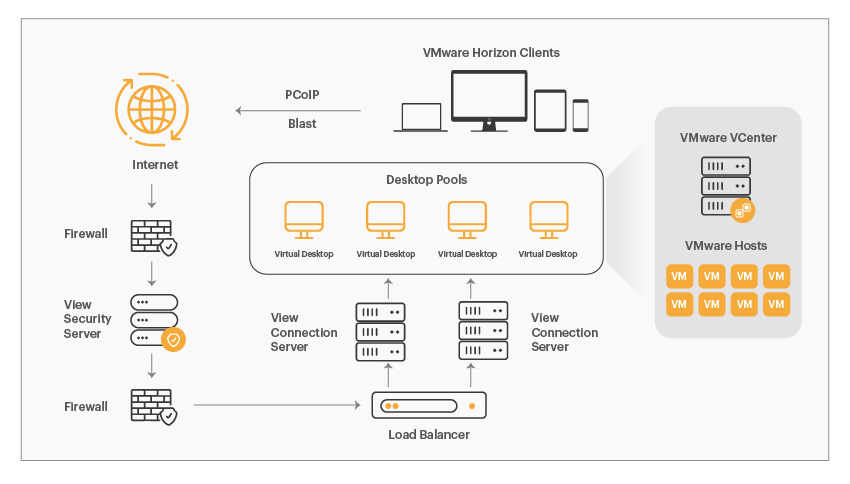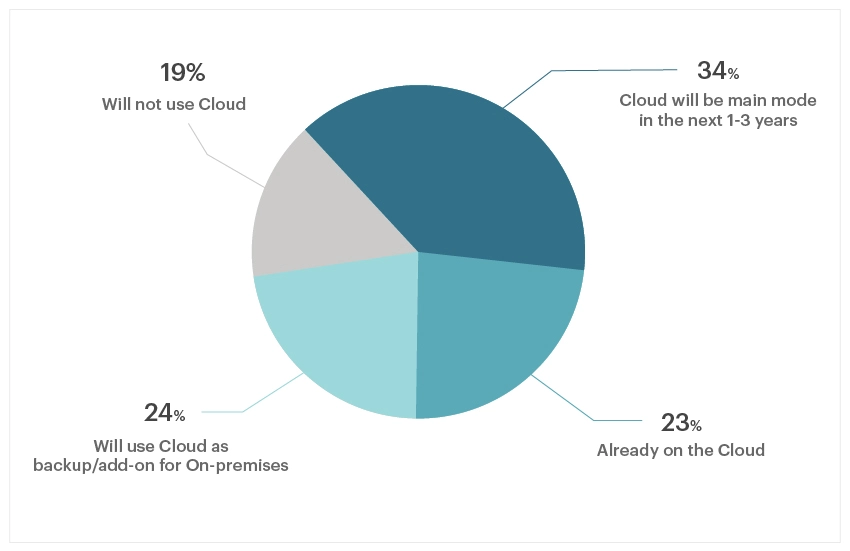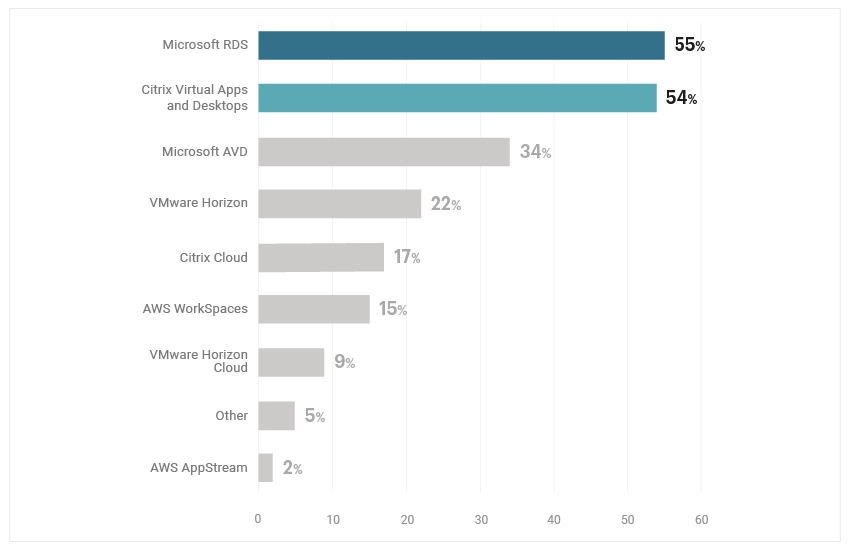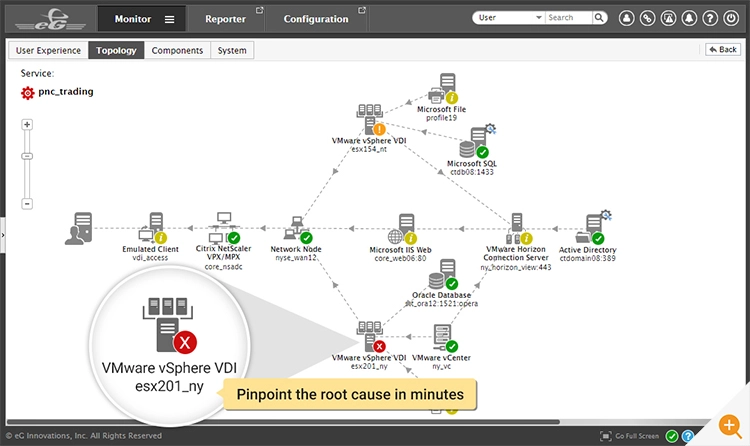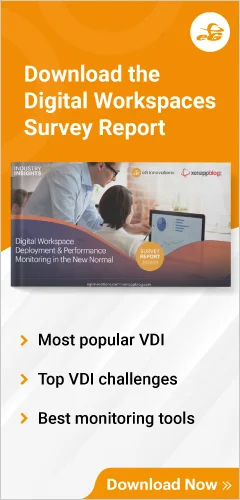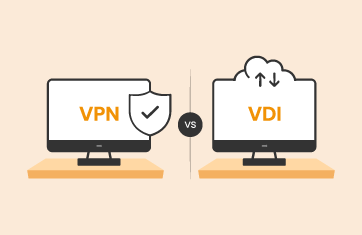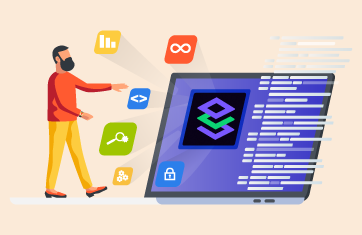What is a Virtual Desktop Infrastructure (VDI)?
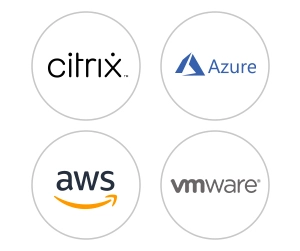 Virtual desktop infrastructure (VDI) is a technology that refers to the use of virtual machines to provide and manage virtual desktops. Users access virtual desktops from their laptops, desktops, thin clients, or mobile devices from anywhere. Virtual desktops are hosted in a data center, on servers, and all the necessary processing is done on the server that hosts the virtual desktops. Hence, VDI provides secure access to remote workers with confidential and proprietary data held securely in the data center. In this blog, we will explore the similarities and differences between the best VDI technologies of today – Citrix, VMware, Azure and AWS.
Virtual desktop infrastructure (VDI) is a technology that refers to the use of virtual machines to provide and manage virtual desktops. Users access virtual desktops from their laptops, desktops, thin clients, or mobile devices from anywhere. Virtual desktops are hosted in a data center, on servers, and all the necessary processing is done on the server that hosts the virtual desktops. Hence, VDI provides secure access to remote workers with confidential and proprietary data held securely in the data center. In this blog, we will explore the similarities and differences between the best VDI technologies of today – Citrix, VMware, Azure and AWS.
eG Innovations has been providing end-to-end IT application and infrastructure monitoring for over two decades (founded in 2001) to enterprises worldwide. One of our long-established core business areas has been the support of VDI and digital workspace technologies both on-premises and more recently within the cloud to offer remote desktops, apps, and services securely.
With comprehensive support within eG Enterprise for all the major vendor stacks including Citrix, Omnissa Horizon, Microsoft RDS and Azure Virtual Desktop, Amazon WorkSpaces, and AppStream 2.0, we have seen and experienced the rationale and factors that drive customers’ choices in practice and indeed see many customers who have adopted multiple workspace technologies to gain the benefits where individual product stacks excel.
Typical VDI Architecture
It’s been over 15 years since VDI was first discussed as an alternative to server-based computing. There are several vendors of VDI technologies today – Citrix with Citrix Virtual Apps and Desktops, VMware with Horizon, AWS with WorkSpaces and AppStream 2.0, Azure Virtual Desktop (AVD), and of course, Microsoft with Remote Desktop Services (RDS). A recent survey on digital workspaces conducted by eG Innovations and XenAppBlog provides more insights into the adoption trends, challenges, and opportunities in leveraging these technologies.
VDI deployments, irrespective of the vendor of choice have become very standardized. Users log in to a portal and once authenticated, they can access their virtual desktop from the browser itself, or through a separate client (e.g., Citrix Workspace App, Horizon client, etc.).
VDI solutions have matured and technologies have evolved to eliminate and mitigate problems in earlier solutions – particularly those associated with poor user experience, slow logons, and application performance issues. Modern VDI solution stacks now routinely include advanced protocols, profile management technologies, and image optimizations.
While the usage model for VDI is simple, there is a significant infrastructure required to support it. Figure 1 below shows a typical Omnissa Horizon-based VDI infrastructure. As you can see, several hardware and software components are required to support virtual desktops.
- The Horizon Unified Access Gateway offers secure external access to your organization’s applications. It is typically deployed in a demilitarized zone (DMZ).
- The Horizon Connection server is responsible for brokering user requests and assigning desktops to them.
- The virtual desktops are hosted on VMware vSphere hosts with VMware vCenter managing the vSphere hosts in clusters.
VDI Deployment Choices
There are some basic choices to be made when deploying VDI:
- Whether VDI should be persistent or not: With persistent VDI, a user connects to the same desktop each time, and users are able to personalize the desktop for their needs since changes are saved even after the session end. In contrast, with non-persistent VDI, users connect to generic desktops and no changes are saved. This is usually simpler and cheaper since there is no need to maintain customized desktops between sessions. Non-persistent VDI is often used in organizations with a lot of task workers, or employees who perform a limited set of repetitive tasks and don’t need a customized desktop; call center-like use cases are an archetypical example.
-
Whether VDI is hosted on-premises, in the cloud, in a hybrid manner, or as SaaS: In a completely on-premises model, all of the VDI components are hosted in the enterprise data center. The VDIs are hosted on hypervisors. In a cloud-hosted model, an enterprise can choose to host all of the VDI components in a public cloud. In the hybrid model, the management plane of VDI (more on this later) is hosted by the cloud provider, but the data plane – the actual virtual desktops are hosted by the enterprise either in their data center or in their cloud tenant. In the SaaS model, the desktops are provisioned by the cloud provider and the enterprise has no hardware or software to manage.
Security, redundancy, reliability, and latency are some of the considerations that come into play when choosing which of these models works best. For example, if the applications being accessed from the virtual desktops are located on-premises, latency and security considerations become important (what is the latency if the desktop is in the cloud, and what firewall rules have to be configured to allow virtual desktops in the cloud to access on-premises applications).
- Whether VDI is shared or dedicated: In a shared session model, multiple users connect to a single machine (typically running a server OS), with each user having a session on that machine. In a dedicated VDI model, each user has their own VM running a desktop OS. They do not share the resources of the VM with any other users. Shared session usage can reduce costs when used appropriately but if it leads to scenarios where a single user is left on a server blocking the shutdown of the server these cost savings can be lost.
The vendor and technology used may differ based on the deployment requirements. Many organizations mix VDI and cloud-hosted DaaS solutions especially where they have a number of different types of use cases and can select the best in breed for each use case.
Choosing the Best VDI Technology for Your Deployment: Citrix, VMware, AWS, Azure
Once you are clear about what you need from a VDI deployment, you can then look at the different VDI offerings in the market. This section covers the pros of the key VDI vendors.
- – Citrix:
- Citrix is widely regarded as the gold standard in VDI. Citrix’s offerings in the end user computing space pre-date the advent of VDI as a deployment option for enterprises. While Citrix products have a lot of capabilities, some users only need a fraction of the features available.
- The HDX/ICA and now EDT protocols used in the Citrix stack to communicate between end-points and the VDIs is highly efficient and has been optimized over the years to support even low bandwidth, lossy networks (see What is Citrix HDX Adaptive Transport). The availability of optimizations packs for UC tools such as Microsoft Teams often influence the decision to choose Citrix in organizations where those apps are considered critical business tools.
- Originally intended to support Microsoft Windows desktops, Citrix technologies have been extended to support Linux workloads as well (see Linux Virtual Desktops and Apps Delivered to Any Device).
- Citrix ADCs (ADC was NetScaler) is a popular choice for LAN, WAN, and SD-WAN optimization, VPNs, and load balancing and this foot in the network optimization stack enables certain protocol optimizations beyond what most in the market can offer.
- Citrix Cloud service is a hybrid cloud offering wherein the management plane is hosted in Microsoft Azure by Citrix and managed by them and enterprises have to operate the control plane – i.e., hypervisors, virtual desktops, etc.
- Citrix technologies have been long established and well-used, and there is a decent pool of expert staff and community knowledge to resource Citrix based projects.
- Particularly strong on apps and desktops and NetScaler (Citrix ADC). Good support for mobile endpoints.
- – Omnissa Horizon:
- VMware’s flagship hypervisor, VMware vSphere ESXi, is the market leader and is widely used even along with the Citrix stack to host VMs. Over the last 5+ years, VMware has rounded out its Horizon VDI offering to support almost all of the capabilities offered by the Citrix stack.
- Besides virtual desktops, virtual applications and shared hosted desktops are also supported using Omnissa Horizon RDSH.
- Lower cost of its VDI offering along with bundled enterprise licensing is often why customers choose Omnissa Horizon. Customers looking for a single vendor solution are also likely to adopt Omnissa Horizon. In comparison, Citrix Hypervisor is not very popular and Citrix clients often use VMware vSphere or Nutanix AHV as the hypervisor.
- Some low-cost options and flexible pricing models which are often attractive and suited to small and medium customers.
Citrix Virtual Apps and Desktops Omnissa Horizon Remote Desktop Services Microsoft RDSH with Citrix Virtual Delivery Agent Microsoft RDSH with Omnissa Horizon Agent User Portal Citrix StoreFront, Citrix Gateway Service Omnissa Horizon Workspace ONE Session Handling and Load Management Citrix Delivery Controllers Horizon Connection Servers Protocol HDX/ICA/EDT Blast Extreme, PCoIp User Environment Management Workspace Environment Manager (WEM) Dynamic Environment Manager Secure Remote Access Citrix ADC/NetScaler VMware Identity Manager Automated Provisioning Machine Creation Services, Provisioning Services Instant Clones, Linked Clones Real Time App Delivery Citrix App Layering VMware App Volumes SSO and App Catalog Citrix Unified Gateway VMware Workspace ONE Access Client Citrix Workspace App/HTML5 Browser Horizon Client or HTML5 Browser Monitoring and Reporting Tools Citrix Director, Citrix Analytics, Citrix ADM vRealize Operations, vROps for Horizon Equivalent functionalities in Citrix and Omnissa Horizon stacks
- – Amazon WorkSpaces and AppStream 2.0
- Amazon WorkSpaces is the persistent VDI solution offering, while AppStream 2.0 is the non-persistent VDI solution. Learn more from our recent blog Amazon AppStream 2.0 vs Amazon WorkSpaces.
- For customers already on the AWS Cloud platform, it is simple to extend their usage to yet another AWS service for digital workspaces.
- AWS WorkSpaces and AppStream 2.0 use different protocols. AWS WorkSpaces used to be based on PCoIP, and now uses WorkSpaces streaming protocol (WSP). AppStream 2.0 is based on NICE DCV. Both offerings have various options for those looking to stream and remote 3D and graphical applications. Update August 2023: Since writing, the WSP has been updated to use NICE DCV technologies.
- Very competitive pricing and a wide range of geographic regional options to aid GDPR like compliance and ensure low latency to the data center are some of the other advantages.
- Monitoring and self-service tools are limited and often a degree of JSON and configuration file modification is inevitable although with this also comes great flexibility.
- The challenges of licensing Microsoft OSs and applications (Office 365 in particular) on AWS have limited the uptake of Amazon WorkSpaces. Update August 2023: some recent changes in licensing were announced that may make Amazon WorkSpaces a more competitive solution for some customers, see: Amazon WorkSpaces finally supports Office 365, but why now? | TechTarget.
- – Microsoft Azure Virtual Desktop
- Low barrier of cost, pay-as-you-go (PAYG) options and minimum complexity to get started making this a feasible option for deployments with less than 250 users. Even an organization with less than 25 users can use AVD. Organizations that found Citrix to be too complex or costly to adopt on a small scale can adopt Microsoft AVD.
- Leverages Microsoft’s reputation as a trusted vendor in the cloud. Respondents to our recent AVD survey (see: Azure Virtual Desktop (AVD) Adoption Trends (eginnovations.com)) rated security as one of the reasons they were considering Microsoft AVD.
- Several choices are provided for regions where the desktops are deployed. This helps with GDPR-type regulatory compliance and data security.
- Simple intuitive GUI allows rapid small-scale projects with minimal knowledge. Naturally being from Microsoft, offers a very strong Windows and Office 365 integration.
- Although progress since the 2019 launch has been phenomenal, it is still a relatively new and evolving product and feature gaps exist compared to more established technologies, particularly for larger, enterprise users with more sophisticated needs.
- Feature and automation gaps mean a reliance and need for additional and supplementary third-party products for monitoring, image optimization, and automation with vendors such as Nerdio, Liquidware, eG Innovations, and Rimo3 plugging gaps.
- Azure costs and calculating them can be complex. Read related blog Azure Virtual Desktop Monitoring – AVD Monitoring Costs
- – Microsoft RDSH
-
- Long-proven and cost-effective choice for remote app delivery. Popular in healthcare to deliver apps from Epic and Cerner.
- Protocol choices and price point mean this is usually more suitable for high-density office apps rather than 3D or graphically demanding applications.
- Mainstream and a well-understood technology.
-
VDI Monitoring
Since there are many tiers of software and hardware involved in supporting a VDI service, any issues, in any of these tiers will impact the VDI service. For example, if a Connection server is down, users may not be able to access their virtual desktops, or if a vSphere host is overloaded, users will experience slowness (e.g., slow screen refresh, screen freezes, disconnects, etc.). Identifying and resolving such situations is a key to delivering great a VDI user and digital employee experience.
This is where VDI monitoring tools come in. A VDI monitoring tool tracks the health of the VDI service (availability and performance) as well as the status of each of the tiers of the infrastructure supporting it. The VDI monitoring tool proactively detects issues, alerts them to VDI administrators, and also provides the diagnosis and insights they need to determine where the performance problems lie. This allows VDI administrators to detect and fix issues quickly – often before these issues are user-impacting.
eG Enterprise offers specialized monitoring for any type of VDI deployment – whether Citrix, Omnissa Horizon, Amazon WorkSpaces/AppStream 2.0, or Microsoft AVD services. With this solution, customers can quickly get to the root cause of slow logons, lag, slow applications, and network issues with true end-to-end and top to bottom monitoring. Vendor agnostic, eG Enterprise can be used in environments that have multiple digital workspace technologies deployed and in hybrid cloud scenarios. It also offers migration routes avoiding vendor lock-in; allowing customers to consistently monitor, test, and optimize competing VDI technologies.
Learn more about VDI monitoring – see VDI Monitoring – Virtual Desktop Monitoring | eG Innovations
eG Enterprise is an Observability solution for Modern IT. Monitor digital workspaces,
web applications, SaaS services, cloud and containers from a single pane of glass.


